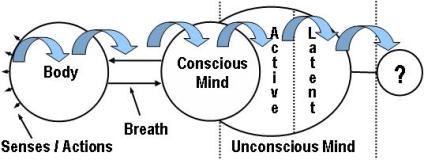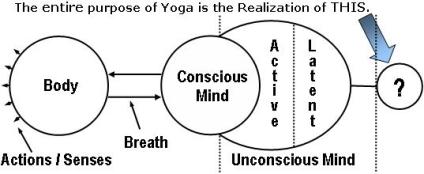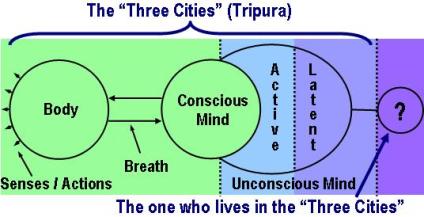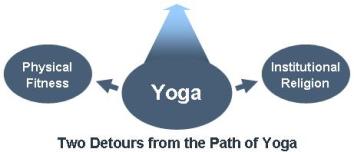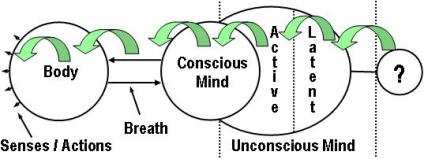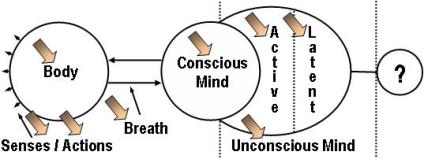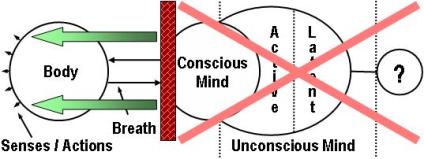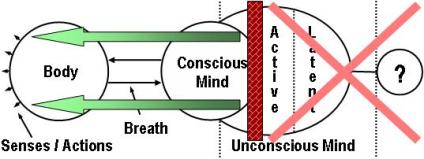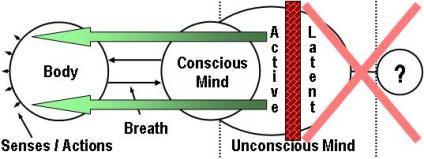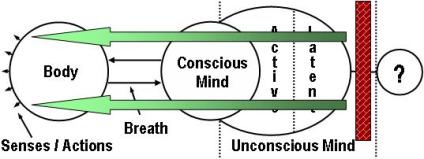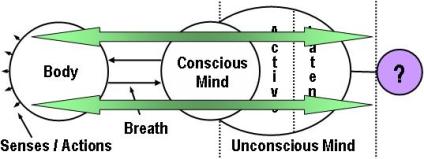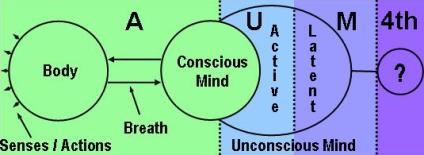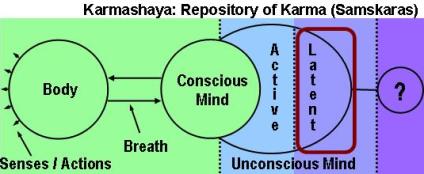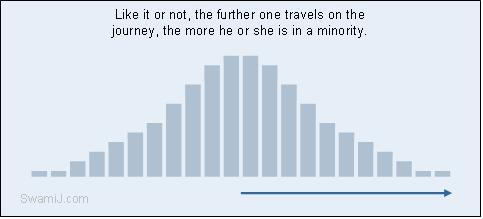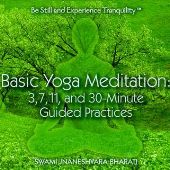|
|
Yoga*Swami Jnaneshvara Bharati
Yoga means to "unite" or "join" the aspects of ourselves which were never really divided in the first place. It also means to "yoke" or to engage ourselves in a self-training program. Yoga means working with each of the levels or aspects of our being individually, and then unifying all of those into their original whole, or Yoga. Yoga is a Sanskrit word coming from the root "yuj" and relates to both the processes or practices referred to as Yoga and also the goal itself, which is also called Yoga. As the goal, the word Yoga is virtually one and the same with the word Samadhi, the deep, transcendent realization of the highest truth or reality.
Click here to read the Hatha Yoga
Pradipika In Yoga Each Level is
Trained:
Awareness then
Recedes to the State of Yoga:
The Goal of Yoga: The goal of Yoga is the highest Joy that comes from the Realization in direct experience of the center of consciousness, the Self, the Atman or Purusha, which is one and the same with the Absolute Reality. (more) Terms for the Goal of Yoga: The goal or destination of Yoga is Yoga itself, union itself, of the little self and the True Self, a process of awakening to the preexisting union that is called Yoga. Yoga has to do with the realization through direct experience of the preexisting union between Atman and Brahman, Jivatman and Paramatman, and Shiva and Shakti, or the realization of Purusha standing alone as separate from Prakriti. Each of these Sanskrit terms relates to the subtleties of Yoga as described in the various paths of Yoga, Vedanta, and Tantra. Blending Traditional Approaches to Yoga: There are four traditional schools of Yoga, and these are: Jnana Yoga, Bhakti Yoga, Karma Yoga, and Raja Yoga. While a Yogi or Yogini may focus exclusively on one of these approaches to Yoga, that is quite uncommon. For the vast majority of practitioners of Yoga, a blending of the four traditional types of Yoga is most appropriate. One follows his or her own predisposition in balancing these different forms of Yoga. (more) Jnana Yoga: Jnana Yoga is the path of knowledge, wisdom, introspection and contemplation. It involves deep exploration of the nature our being by systematically exploring and setting aside false identities. Bhakti Yoga: Bhakti Yoga is the path of devotion, emotion, love, compassion, and service to God and others. All actions are done in the context of remembering the Divine. Karma Yoga: Karma Yoga is the path of action, service to others, mindfulness, and remembering the levels of our being while fulfilling our actions or karma in the world. Raja Yoga: Raja Yoga is a comprehensive method that emphasizes meditation, while encompassing the whole of Yoga. It directly deals with the encountering and transcending thoughts of the mind. Yoga Texts: The methods of Yoga are described in many texts, but are particularly explained in the Yoga Sutras, Upanishads, Bhagavad Gita, and the Hatha Yoga Pradipika. Notable among these is the Yoga Sutras, as it is a succinct, yet thorough outline of the entire process of Yoga leading to the goal called Yoga. (more on Upanishads; more on Yoga Sutras; more on Hatha Yoga Pradipika) Beginning, Intermediate, and Advanced Yoga Meditation: The phrases Beginning, Intermediate and Advanced are being used here solely because we are all familiar with this language. The six subcategories presented are very broad, applying to virtually any system of meditation, though it draws upon Yoga meditation of the Himalayan masters. This outline attempts to capture the entire process of Yoga meditation, from beginning to the height of direct experience. By understanding this general process, it is much easier to learn and do the practices themselves. (more) Art and Science of Yoga Meditation: Yoga Meditation is the art and science of systematically observing, accepting, understanding, and training each of the levels of our being, such that we may coordinate and integrate those aspects of ourselves, and dwell in the direct experience of the center of consciousness. There is a 16-page description of traditional Yoga Meditation, which explains the process in practical terms, and simple language. (more) Yoga Sutra 1.2 Defines Yoga: Yoga is the control (nirodhah, regulation, channeling, mastery, integration, coordination, stilling, quieting, setting aside) of the modifications (gross and subtle thought patterns) of the mind field. (more) Yoga and Six Schools of Indian Philosophy: To understand the true nature of Yoga as a path of spiritual realization, it is necessary to have some small understanding of the six classical schools or systems of Indian philosophy, of which Yoga is one. By understanding Yoga in that context, it is easier to more fully delve into Yoga as the enlightenment practice that it actually is, rather than the mere physical fitness program it has come to be known as. (more) Funk & Wagnalls Definition of Yoga: (Skt. yuga, “yoke”), one of the six classic systems of Hindu philosophy, distinguished from the others by the marvels of bodily control and the magical powers ascribed to its advanced devotees. Yoga affirms the doctrine that through the practice of certain disciplines one may achieve liberation from the limitations of flesh, the delusions of sense, and the pitfalls of thought and thus attain union with the object of knowledge. Such union, according to the doctrine, is the only true way of knowing. For most Yogi (those who practice Yoga), the object of knowledge is the universal spirit Brahma. A minority of atheistic Yogi seek perfect self-knowledge instead of knowledge of God. In any case, it is knowledge and not, as is commonly supposed, feats of asceticism, clairvoyance, or the working of miracles, that is the ideal goal of all Yoga practices. Indeed, Yoga doctrine does not approve of painful asceticism; it insists that physical and mental training is not to be used for display but only as a means to spiritual ends. (more) Tradition of the Himalayan Yoga Masters: The systematic practice of Yoga Meditation comes from the ancient cave monasteries of the Himalayas, the source of the mystical Shangrila or Shambala. This lineage of teachers is at least 5,000 years old, though eternal in nature. (more) Sankhya and Yoga: The process of Self-realization is one of attention reversing the process of manifestation, of retracing consciousness back through the levels of manifestation to its source. To have a general understanding of this process is extremely useful, if not essential in the practice of Yoga. What we now call "Yoga" or "Raja Yoga" has also been called "Sankhya-Yoga," since the practical Yoga methods rest on the philosophical foundation of Sankhya. (more) Yoga Darshana: Yoga darshana is one of the most ancient darshanas. The word darshana comes from the root drishyate anena which means, “that through which you can see.” That particular system through which you can see Reality is called darshana. Just as you can see yourself in the mirror, so also, through Yoga darshana, the Yoga Sutras, can you see the Self. Darshana is not the same thing as philosophy. Philosophy is a compound word meaning “love for knowledge.” Darshana is not a mere love for knowledge. This is one difference between oriental and occidental philosophy: the ultimate goal of darshana is to see Reality. Yoga science is based on Samkhya philosophy, which is the very basis of all sciences. Samkhya (samyag akhyate) means, “that which explains the whole.” Samkhya embraces the whole universe—how the universe came into existence, and all relationships within the universe. (more) Upanishads and Yoga: Upanishad is the subtler, mystical or yogic teachings of the philosophy and practices leading to the direct experience of the center of consciousness, the absolute reality. "Upa" means "near;" "ni" means "down;" "shad" means "to sit." Thus, Upanishad is to sit down near the teacher to discuss, learn, practice and experience the means and goals of Yoga sadhana or practices. The Upanishads are also known as Vedanta, which means the end or culmination of the Vedas. (more) Tantra and Yoga: Tantra is one of the three streams of the triad of Yoga-Vedanta-Tantra. Tantra Yoga considers the universe to be a manifestation of pure consciousness. Through this process of manifesting, consciousness divides itself into two parts, which cannot exist without one another (though appearing to divide, they actually remain one and the same). One aspect remains as a static, formless quality (shiva), while the other is a dynamic, creative aspect (shakti). The two eternally coexist, like ink and the written word, which, though one and the same, are different. The journey of Tantra Yoga is to know them both, at once, as one. (more)
Modern Yoga and Traditional Yoga: There has been a significant shift in the public perception of Yoga in recent years, whereby the approaches and goals of traditional Yoga are virtually ignored, and replaced with mere physical fitness programs. (more) Yoga and Institutional Religion: Unlike religions, Yoga itself has no deity, worship services, rituals, sacred icons, creed, confession, clergy, institutions, congregation, membership procedure, or system of temples or churches. The word “Yoga” means “union” referring to the direct experience of the wholeness of ourselves at all levels. While the word “Yoga” comes from traditional Sanskrit language, that union is a universal process. The inner calling for that wholeness has also been called the “mystic” longing. (more) Is Yoga a Religion? Yoga is in Religion. Religion is not in Yoga. While Yoga may be in Religions, the many Yoga practices with body, breath and mind, along with their transcendent goal of direct experience, are generally neither characteristic of Religions, nor typically practiced by the adherents of Religions. (more) Mysticism, Yoga, and Religion: Mysticism and Yoga can be practiced either within the context or religion, or outside of it. Yoga and Mysticism are on the esoteric end of the the esoteric-exoteric polarity. (more) Yoga Meditation is a Systematic Process: Yoga meditation is a systematic process, in which you work with the grosser, or more external aspects of your being, and then move inward, doing the more subtle practices, which gently brings you to meditation. (more)
Avidya and Adhyasa, Veiling and Projecting: Avidya and Adhyasa are two processes in Yoga that are extremely useful to understand. These two work as a pair so as to take us evermore out into the external world. Receding back through these two leads us inward to the direct experience of Samadhi, Turiya, or Self-Realization. Once the basic principles of Avidya (Veiling, Ignorance) are understood, as well has how they progressively move awareness outward through Adhyasa (Projecting, Superimposition), it is easier to see the way in which these two are systematically reversed so as to attain the highest goals of traditional Yoga. (more) Diaphragmatic Breathing is Essential to Yoga: Conscious diaphragmatic breathing is extremely relaxing to the autonomic nervous system and is essential preparation for deep Yoga meditation. Of particular importance is the practice of consciously, mindfully making the transitions between breaths very smooth, eliminating the pause between exhalation and inhalation, and between inhalation and exhalation. (more) Yoga Nidra: Yoga Nidra means yogic sleep, a state of conscious deep sleep for extreme relaxation and subtler spiritual exploration. (more) Witnessing Your Thoughts and Yoga: Yoga science maps out many aspects of the mental process so that the student of Yoga meditation can encounter, deal with, and eventually go beyond the entire thought process to the joy of the center of consciousness. (more) Om Mantra and Yoga: One of the finest roadmaps of Yoga is the process outlined in Om Mantra. There are four main levels of consciousness outlined in the OM Mantra, along with three transition levels, which is a total of seven levels. Each of these is experienced on the inner journey of Yoga meditation and contemplation. (more) Yoga is a Science: Yoga science does not tell you what to do and what not to do, but teaches you how to be. Yoga science is a science of life that helps you to know the known and unknown parts of life, that helps you to liberate yourself from pains and miseries, and that helps you to attain that state which is free from pains and miseries. (more) Yoga, Vedanta, and Tantra: In the tradition of the Himalayan masters, Yoga, Vedanta, and Tantra complement one another, leading one systematically along the path to Self-realization. The aspirant clears the mind through the practice of Yoga meditation as codified in the Yoga Sutras of Patanjali, does self-enquiry of Vedanta, and then breaks through the final barrier with Tantra, experiencing the heights of kundalini awakening. (more) Steps in Yoga Meditation: Yoga meditation is a systematic process, in which you work with the grosser, or more external aspects of your being, and then move inward, doing the more subtle practices, which gently brings you to meditation. The amount of time spent with each of the practices may vary, depending on your own training and predispositions. The total length of practice (all four) may also vary (more) Flexibility in Yoga Meditation: Students of Yoga Meditation have different inclinations towards the practice stages of preparation, hatha Yoga or stretches, relaxation, breathing, and meditation. Some may like to spend a long time with the body, while others prefer breathing exercises, and still others seek the stillness of meditation. Each of these stages work together, one leading into the next. There is no perfect, one-size-fits-all formula in Yoga Meditation. It is best to spend the amount of time with each stage that is just right for you. (more) Who Benefits from Yoga Meditation? Yoga Meditation systematically deals with all levels of your being, including your relationship with the world and with yourself. It deals with the senses, body, breath, all the levels of mind, and that which is beyond your mind, often called spirit, soul, consciousness, or Self. Who benefits from Yoga Meditation? Ask these few, simple questions.... (more) Time and Place for Yoga Meditation: The time you choose should be comfortable for you, and should fit in with your daily schedule and the schedule of others. Ideally, the better times for meditation are early morning or late evening. The ancient teachers of Yoga meditation say that the ideal time is about 3:00 or 4:00 am. The times just around sunrise and sunset are also particularly nice for meditation. Although such times may be theoretically better than other times, they may not be right for you personally if they do not match your schedule, your current predisposition for meditation, or the people with whom you live. The real key to regularity of meditation is to choose a time that works for you. (more) Seven Skills for Yoga Meditation: There are many Yoga techniques that can be learned. In pursuing those techniques, one can be left with a bewildering sense of uncertainty about "why" all of the methods are being learned, aside from a general idea that the methods are for "Self-Realization" or "Enlightenment".... In the link are seven skills to cultivate for Meditation. It is the skill we want to learn, not merely techniques (though, again, the techniques are quite useful). For example, we want to gain the ability to directly relax the body, smoothen the breath, and quiet the mind in a moment, with no technique needed to do it. (more) Four Functions of Mind Explored in Yoga: This is one of the most profound self-awareness practices of the Yoga of the ancient Himalayan sages. This Yoga practice is just as profoundly useful today as it was thousands of years ago. The process is one of self-observation, and gradually discriminating between these four aspects of the inner instrument, so as to attain the direct experience of the Center of Consciousness from which all of our thoughts, emotions, and experiences arise on various degrees and grades. The Four Functions of mind in Yoga are: 1) Manas: sensory, processing mind, 2) Chitta: storage of impressions, 3) Ahamkara: "I-maker" or Ego, 4) Buddhi: knows, decides, judges, and discriminates. (more) Yoga and the Chariot Metaphor: The chariot is used by the ancient Yoga sages as a symbol for how to train your mind and senses. Though most of us do not use horse drawn chariots, the lesson is as practical today for Yoga as it was thousands of years ago. Allow your mind to visualize this image, and it will become a wonderful tool in your Yoga practices and daily spiritual life. (more) Clearing the Clouded
Mind through Yoga: Three of the problems that are frequently
mentioned in the teachings of the ancient sages of Yoga when speaking of
finding the Truth or Absolute Reality: 1) The external world keeps
changing, 2) The senses are unreliable, 3) The mind is clouded Clearing
the clouded mind (more) Kundalini Awakening and Yoga: At the base of the spine, subtler than the physical body, lies the Kundalini energy, or spiritual energy, in a latent form. Regardless of what religious, spiritual, or meditation tradition one follows, the awakening of this energy, by whatever name you call it, is a most innate and essential part of spiritual advancement, unfoldment, or realization. While some use a specific terminology "Kundalini Yoga" for certain practices, all of Yoga actually leads to the activation of Kundalini. Thus, in a sense, all of Yoga is Kundalini Yoga, regardless of whether you use that specific name. (more) Five Sheaths or Koshas of Yoga Vedanta: We humans are like a lamp that has five lampshades over our light. Each of the lampshades is a different color and density. As the light shines through the lampshades, it is progressively changed in color and nature. It is a bitter-sweet coloring. On the one hand, the shades provide the individualized beauty of each lamp. Yet, the lampshades also obscure the pure light. The Yoga path of Self-realization is one of progressively moving inward, through each of those lampshades, so as to experience the purity at the eternal center of consciousness, while at the same time allowing that purity to animate through our individuality. These five levels are called koshas, which literally means sheaths. (more) Witnessing Thoughts in Yoga Practice: Witnessing your thoughts is a most important aspect of Yoga practice. Witnessing the thought process means to be able to observe the natural flow of the mind, while not being disturbed or distracted. This brings a peaceful state of mind, which allows the deeper aspects of meditation and samadhi to unfold, revealing that which is beyond, which is Yoga or Unity. (more) Money, Sex, Fame, Health and Yoga: Everybody wants happiness. However, we usually seek it in ways that are dependent on external stimulus, as if an outer cause leads to an inner effect of happiness. Surely this process of stimulus-response works to some degree; we have all experienced this in different ways, where getting what we want seems to make us feel good, and not getting what we want seems to make us feel bad. However, what if we knew how to be happy without any stimulus whatsoever? What if you could just rest in the deepest feeling of joy, regardless of the external circumstances? (more) Four Levels and Three Domains in Yoga: The three states of consciousness in Yoga are 1) Waking, 2) Dreaming, and 3) Deep Sleep. The three states of mind in Yoga are 1) Conscious, 2) Unconscious, and 3) Subconscious. The three states of manifestation in Yoga are 1) Gross, 2) Subtle, and Causal. (more) Great Contemplations of Yoga Vedanta: The Mahavakyas are the Great Sentences of Advaita Vedanta and Jnana Yoga, and are contained in the Upanishads. Maha is Great, and Vakyas are sentences, or utterances for contemplation. They provide perspective and insights that tie the texts together in a cohesive whole. The contemplations on the Mahavakyas also blend well with the practices of Yoga meditation, prayer, and mantra, which are companion practices in Yoga. (more) Mandukya Upanishad and Yoga: The pinnacle of the wisdom and practices of the ancient sages of Yoga is contained in the terse twelve verses of the Mandukya Upanishad, which outlines the philosophy and practices of the OM mantra. It has been said that the juice of the Vedas is in the Upanishads, and the juice of the Upanishads is in the Mandukya Upanishad. OM Mantra is also suggested as a direct route to samadhi in the Yoga Sutras. (more) Mantra Yoga: Mantra practice is a central aspect of traditional Yoga. Mantra japa (repeating or remembering mantra) can seem a bit complex when we ask what one should or should not do, or what is right versus wrong to do. Actually, two seemingly opposite practices can both be useful, with one simply being subtler than the other, or having a greater tendency to lead attention inward. One method may be a starting place that naturally evolves into the other. (more) Ten Senses or Indriyas in Traditional Yoga: In traditional Yoga philosophy and practice, the human being is seen as being like a building with ten doors. Five are entrance doors, and five are exit doors. Consciously, actively and intentionally witnessing these ten senses as they function is an important part of Yoga meditation, and meditation in action. (more) Integrating 50+ Methods of Yoga Meditation: The sages of the Himalayas practice a variety of methods, systematically moving inward, from gross to subtle, to subtler, and subtle most. The Yoga meditation of the Himalayan tradition is a complete meditation system, dealing with all the levels of your being. Exploring all of those levels involves meditation in Yoga, tantra, and vedanta. Eventually it leads to the direct experience of the Absolute reality, the Self, that is not subject to death, decay, or decomposition. (more) Meaning and Purpose of Yoga: Like many arts and sciences that are profound, beautiful, and powerful, Yoga has suffered from the spiritual poverty of the modern world--it has been trivialized, watered down, or reduced to cliches. The deep and eternal essence of Yoga has been misrepresented and packaged for personal profit by clever people. At the hands of some, Yoga has been reduced to the status of just another exercise program available on videotape. In other contexts, Yoga has been presented as a cult religion, aimed at attracting "devotees." Such a haze of confusion has been created around the clear and pure concept of Yoga that it is now necessary to redefine Yoga and clarify its meaning and purpose. Yoga defines itself as a science--that is, as a practical, methodical, and systematic discipline or set of techniques that have the lofty goal of helping human beings to become aware of their deepest nature. The goal of seeking to experience this deepest potential is not part of a religious process, but an experiential science of self-study. (more) Yoga and the Stages of Life: In the ancient Indian tradition, one planned the years of life in four ashrams or stages, with the style of Yoga practiced in each stage chosen to match the circumstances of that stage. A life of 84+ years was sought, with each of the four stages being 21 years. Some have revised these into four stages of 25 years, seeking a life of 100+ years. The purpose for this life planning is to attain the direct experience of Self-realization, Yoga or enlightenment here, in this world, in this very life. While our lifestyles may have changed since then, the basic idea of these four stages is as sound today as it was then. (more) Bindu, the Convergence of Yoga, Vedanta and Tantra: Bindu means Point or Dot, is sometimes likened to a Pearl, and is often related to the principle of a Seed. This is not just a poetic choice of words or philosophy. There literally is a stage of Yoga Meditation in which all experiences collapse, so to speak, into a point from which all experiences arose in the first place. The experience of Bindu is an actual, internally experienced reality, which is the convergence point of the highest principles and practices of Yoga, Vedanta, and Tantra. Seeking to experience and then transcend the Bindu serves as an organizing principle and focal point for all of those spiritual or yogic practices that are intended to lead one to direct experience. (more) Centripetal and Centrifugal - Two Forces in Yoga: There is a principle in physics that is also applicable to human beings, and which is extremely useful to understand and put into practical use. That is, there are two forces at play; one is moving outward, while the other is moving inward. To have only one, without the other, can lead to being out of balance, to either being lost in the world or to living a life of escapism. To fully experience them both, and to have them in a harmonious balance is a very high way of living in Yoga. (more) Karma and the Sources of Actions, Speech, and Thoughts: The word Karma literally means action. It may appear that Karma is happening to us, as if some outside force is causing good things or bad things to come to us. However, it is really our own inner conditionings and processes that are leading us to experience outer effects or consequences in relation to our own actions. To understand the meaning of Karma, and to reduce it's control through Yoga, one needs to understand another term, and that is Samskara. Karma literally means actions, and those actions come from the deep impressions of habit that are called Samskaras. To purify or attenuate the Samskaras while one is doing actions in the world is the Yoga known as Karma Yoga. This involves being aware or mindful of our actions and speech, and seeing their sources in emotions and the subtler processes of the mind. Karma Yoga also involves doing our actions in ways, which are of benefit to others (service or seva), freeing ourselves from the cycles of feeding egotism. (more) Three Kinds of Karma in Yoga Sadhana: In Yoga Meditation, Karma is of three kinds: Sanchita, Kriyamana, and Prarabhda, using a metaphor of three kinds of arrows in archery. Karma Yoga is the Yoga that emphasizes doing Yoga while also doing actions in the world, or Meditation in action. (more) Uncoloring Colored Thoughts through Yoga: thought patterns in the mind field can be colored with fear, aversion, attachment, egoism, or ignorance of our true nature (the five kleshas described by Yoga; Yoga Sutra 1.5, 2.3). These colored thoughts (vrittis) are the obstacles blocking the light, peace, and joy of the core of our spiritual being. Reducing the coloring is the key to non-attachment (vairagya) and freedom. (more) Breathing and Pranayama in Yoga: In Yoga Meditation, breath training is essential preparation for deep meditation and samadhi, on the path to Self-Realization. Breath is the bridge between the body and the mind. Regulate breath, and the body and mind will follow. (more) Yoga Practice and Non-Attachment: Practice (abhyasa, Yoga Sutra 1.13) and non-attachment (vairagya, Yoga Sutra 1.15) are the two core principles on which the entire system of Yoga rests (Yoga Sutra 1.12). It is through the cultivation of these two that the other practices evolve, by which mastery over the mind field occurs (Yoga Sutra 1.2), and allows the realization of the true Self (Yoga Sutra 1.3). (more) Types of Concentration in Yoga: Building upon practice (abhyasa) and non-attachment (vairagya) (Yoga Sutras 1.12-1.16), the meditator systematically moves inward, through four levels or stages of concentration on an object (Yoga Sutra 1.17), and then progresses to the stage of objectless concentration (Yoga Sutra 1.18). (more) Five Efforts and Commitments in Yoga: There are five foundations for the practitioner of Yoga meditation outlined in Yoga Sutra 1.20. Shraddha is developing the faith that you are going in the right direction. Virya is committing the energy to go there. Smriti is cultivating memory and mindfulness. Samadhi is seeking the states of deep absorption. Prajna is pursuing the higher wisdom. Yoga rests on these foundations. (more) Direct Route of Yoga through AUM Mantra: The direct route to the final union of Yoga is through AUM, which is outlined in Yoga Sutras 1.23-1.29. This practice takes one on a direct route inward, systematically piercing the levels of consciousness. It is done with sincerity and dedication (Yoga Sutra 1.23) towards the untainted creative source or pure consciousness (Yoga Sutra 1.24), which AUM represents (Yoga Sutra 1.27). That consciousness contains the seed of omniscience (Yoga Sutra 1.25), which is the source of the teachings of all the ancient sages (Yoga Sutra 1.26). (more) Obstacles to Yoga and the Solution for them: There are a number of predictable obstacles (Yoga Sutra 1.30) that arise on the inner journey of Yoga, along with several consequences (Yoga SUtra 1.31) that grow out of them. While these can be a challenge, there is a certain comfort in knowing that they are a natural, predictable part of the process of Yoga. Knowing this can help to maintain the faith and conviction that were previously discussed as essential (Yoga Sutra 1.20). (more) Stabilizing and Clearing the Mind in Yoga: Stability and clarity of mind are necessary before being able to experience the subtler practices of Yoga. The specialized training of an olympic athlete rests on a solid foundation of generalized physical fitness. Similarly, generalized training in one-pointedness is necessary so that Yoga meditation practices can advance. Five specific suggestions of objects for focus of attention are given in Yoga , including breath awareness, sensation, inner luminosity, contemplation on a stable mind, and focusing on the stream of the mind (Yoga Sutras 1.34-1.38). (more) Four Attitudes in Yoga: There are four basic attitude meditations of Yoga. The mind becomes purified by cultivating feelings of friendliness towards those who are happy, compassion for those who are suffering, goodwill towards those who are virtuous, and indifference or neutrality towards those we perceive as wicked or evil. In Yoga these are practiced both at the time of seated meditation and during daily life, or meditation in action, part of Karma Yoga. (more) Kriya Yoga: In
the
first few sutras of Chapter 2 of the Yoga Sutras, specific methods are
introduced on how to minimize the gross colorings (kleshas)
of the mental obstacles, which veil the true Self. (The later sutras of
this chapter deal with the the subtle colorings of mental
obstacles).
The first part of the process of minimizing the gross coloring is called
Kriya Yoga, and leads one in the direction of samadhi. Kriya Yoga
involves three parts (Yoga Sutras 2.1-2.2): Dealing with Subtle Thoughts through Yoga: Once the gross coloring has been minimized through Kriya Yoga (Yoga Sutras 2.1-2.2), and the intensity of the colorings have been attenuated (Yoga Sutra 2.4), the thought patterns are brought back to the seed, or latent form by the process of Yoga meditation (Yoga Sutra 2.11). (more) Breaking the Alliance of Karma through Yoga: The key to breaking the cycle of karma is that the connection between "seer" and that which is "seen" is set aside (Yoga Sutra 2.17). This allows one to avoid even the future karmas that have not yet manifested (Yoga Sutra 2.16). Ignorance, or avidya (Yoga Sutra 2.5), is the cause of this alliance (Yoga Sutra 2.24), and eliminating this ignorance is the means of ending the alliance (Yoga Sutra 2.25). This, in turn, breaks the cycle of karma. (more) Purpose of Eight Rungs of Yoga is Discrimination: The reason for practicing the eight rungs of Yoga (Yoga Sutra 2.29) is to develop attention as the tool for discriminative knowledge, which is the means to discriminative enlightenment and liberation. It means using razor-like attention (Yoga Sutras 3.4-3.6) to separate the seer and the seen (Yoga Sutra 2.17), so as to break the alliance of karma (Yoga Sutras 2.12-2.25), and to get past the four mistakes of ignorance, or avidya (Yoga Sutras 2.24-2.25), which are: 1) confusing the temporary for the eternal, 2) the impure for the pure, 3) misery for happiness, and 4) the false self for the true Self (Yoga Sutra 2.5). Resulting from this systematic discrimination, the seer or Self is eventually experienced in its true nature (Yoga Sutra 1.3). (more) Self-Regulation and Self-Training in Yoga: Non-injury or non-harming (ahimsa), truthfulness (satya), abstention from stealing (asteya), walking in awareness of the highest reality (brahmacharya), and non-possessiveness or non-grasping with the senses (aparigraha) are the five yamas, or codes of self-regulation or restraint, and are the first of the eight steps of Yoga. Cleanliness and purity of body and mind (shaucha), an attitude of contentment (santosha), ascesis or training of the senses (tapas), self-study and reflection on sacred words (svadhyaya), and an attitude of letting go into one's source (ishvarapranidhana) are the observances or practices of self-training (niyamas), and are the second rung on the ladder of Yoga. (more) Benefits of Yamas and Niyamas of Yoga: As one practices the Yamas and Niyamas, it appears that some secondary ability or benefit comes. This process is described as attainment, fruits, acquisition, etc.. However, it is important to note that, while these are attainments in one sense, they really result from the unfoldment of what is already there, by the removal of obstacles. At the beginning of the Yoga Sutras this was described as disidentifying with the modifications of the mind field (Yoga Sutra 1.2). In a later sutra this process is described as being like a farmer opening a sluice gate to allow the water to naturally flow, so as to irrigate a field (Yoga Sutra 4.3). (more) Asana or Posture in Yoga: The third of the eight rungs (Yoga Sutra 2.29) of Yoga is Asana, or sitting posture for the later rungs. The word Asana comes from the root ~as, which means "to sit". Yoga has been defined as the mastery of the thought patterns of mind field (Yoga Sutra 1.2), so that Self-realization can be experienced (Yoga Sutra 1.3). To be able to do the meditation practices that allow this, it is essential that the posture be (Yoga Sutra 2.46) steady and comfortable. (more) Pranayama and Yoga: The fourth of the eight rungs (Yoga Sutra 2.29) of Yoga is Pranayama, which is regulating the breath so as to make it slow and subtle (Yoga Sutra 2.50), leading to the experience of the steady flow of energy (prana), which is beyond or underneath exhalation, inhalation, and the transitions between them (Yoga Sutra 2.51). The three pranayamas are exhalation, inhalation, and the transition (Yoga Sutra 2.50). However, the fourth pranayama is that continuous prana which surpasses, is beyond, or behind the others (Yoga Sutra 2.51). The experience and repeated practice of this fourth pranayama thins the veil of karma, which usually clouds the inner light, allowing that to come shining through (Yoga Sutra 2.52). To successfully practice and attain the full benefits of breath control and pranayama, it is necessary that it be built on the solid foundation of a steady and comfortable sitting posture (Yoga Sutras 2.46-2.48). Through these practices and processes of pranayama the mind acquires or develops the fitness, qualification, or capability for concentration (dharana), which is the sixth rung (Yoga Sutras 3.1-3.3). (more) Pratyahara and Yoga: Pratyahara is the withdrawal of the senses (indriyas) of cognition and action from both the external world and the images or impressions in the mind field (2.54). The senses are said to follow the mind in the same way the hive of bees follows the queen bee. Wherever she goes, they will follow. Similarly, if the mind truly goes inward, the senses will come racing behind. Pratyahara is rung five of the eight rungs. (more) Dharana, Dhyana,
Samadhi, and Yoga: The last three rungs of Yoga are Dharana
(concentration), dhyana (meditation), and samadhi. Dharana is
concentration, the process of holding or fixing the attention of mind
onto one object or place (Yoga Sutra 3.1). Dhyana is meditation,
sustained concentration, whereby the attention continues to hold or
repeat the same object or place (Yoga Sutra 3.2). Samadhi is the deep
absorption, wherein only the essence of that object, place, or point
shines forth in the mind, as if the mind were devoid even of its own
form (Yoga Sutra 3.3). (more) Witnessing Subtle
Transitions in Yoga: You become witness not only to thoughts as we
normally think of thoughts, but also to the transition process of how
they are coming, being, and going. Nirodhah: You become witness to the
process of transitioning into mastery over thought patterns (nirodhah-parinamah),
since that transition is an object. Samadhi: You become witness to the
process of transitioning into the higher state of meditation (samadhi-parinamah),
since that transition is an object. Ekagra: You become witness to the
process of transitioning into one-pointedness of mind (ekagra-parinamah),
since that transition is an object. (more) Higher Discrimination of Yoga: Knowledge of the distinction between the purest aspect of mind (sattvic buddhi) and consciousness itself (purusha) brings supremacy over all forms or states of existence, as well as over all forms of knowing. However, that discrimination between that purest aspect of mind (sattvic buddhi) and consciousness itself (purusha) will bring them to a point of equality. This brings absolute liberation, independence, or freedom (kaivalya), which is the goal of Yoga. (more)
The Three Gunas of Yoga: All of the subconscious mental impressions are made of the same stuff. There is no more straightforward, simple English way to say it. All of these subconscious mental impressions manifest from the three primal elements or gunas. The three gunas all manifest together, and the result is the appearance of a single object, rather than seeing the parts which make up the whole. Only the composite is seen, not the components. The subconscious impressions (which are all constructed from these three gunas) are all witnessed by pure consciousness or purusha (Yoga Sutra 4.18). In these extremely subtle experiences or realizations, one comes to see that there is really very little to know (Yoga Sutra 4.31), and gradually the three gunas recede back into the prakriti from which they arose, along with the realization of liberation or kaivalya (Yoga Sutra 4.34). (more) The Resolution of Questions through Yoga: For one who has experienced this distinction between seer and this subtlest mind, the false identities and even the curiosity about the nature of one's own self come to an end. All of the questions of life eventually boil down to only a few, such as: Who am I? Where did I come from? Why am I here? Where am I going? After the yogi has explored the many currents and cross currents of the gross and subtle mind, there comes the realization of the separateness from all of these levels and pure consciousness. It is then, that all of these questions cease. It is not a case that they are analytically answered in logical words. Rather, the questions are resolved; they simply evaporate in understanding. (more)
-------
|
|
|||||||||||||||||||||||||||||||||||||||


